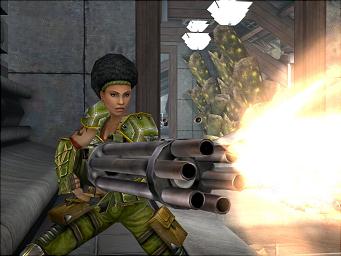
Shot from UT2004
Epic’s ubiquitous Unreal Engine has been treated with much respect by those in the know. Powering games like Deus Ex: Invisible War, Thief: Deadly Shadows, Pariah, Rainbow Six 3, Splinter Cell and Unreal Tournament 2004 (well, duh!) its technical prowess has had wide reaching consequences.
Although the latest Unreal game is yet to be announced, Epic have given a technical demonstration of what can be done with their new Unreal 3.0 engine. For the tech-spec hungry statistic boffins, there’s the full lowdown at www.unrealtechnology.com. For those that don’t know their ‘High Dynamic Range Rendering Pipelines’ from their ‘Pre-computed Bump-granularity Spherical Harmonic Maps’, then here’s an approximate translation of what improvements you can expect...
VISUAL FEATURES
More precise colours and enhanced lighting effects.
Dynamic shadow effects with greater accuracy.
Seamless transition of indoor to outdoor lighting effects.
More accurate distance fogging
PHYSICS
Improved ragdoll character animation
More complex interaction with objects and vehicles
Full support for physics-reliant vehicles
Physics modelling tool built into UnrealEd
ANIMATION
More complex skeletal animation
Cunning tree system for animated objects, e.g. character eyes moving to track other players.
GAME FRAMEWORK & ARTIFICIAL INTELLIGENCE
Path-finding A.I. allowing enemies to navigate temporary obstructions.
Improved objective management and long-term goals for AI based teams.
AI paths editable in UnrealEd.
‘UnrealMatinee’ provides more creative in-game cinematics
Based on previous experience, it would be foolhardy to suggest this the Unreal 3.0 engine will be any less popular with development teams than its previous model. The next actual Unreal game should show how it’s done.
Although the latest Unreal game is yet to be announced, Epic have given a technical demonstration of what can be done with their new Unreal 3.0 engine. For the tech-spec hungry statistic boffins, there’s the full lowdown at www.unrealtechnology.com. For those that don’t know their ‘High Dynamic Range Rendering Pipelines’ from their ‘Pre-computed Bump-granularity Spherical Harmonic Maps’, then here’s an approximate translation of what improvements you can expect...
VISUAL FEATURES
More precise colours and enhanced lighting effects.
Dynamic shadow effects with greater accuracy.
Seamless transition of indoor to outdoor lighting effects.
More accurate distance fogging
PHYSICS
Improved ragdoll character animation
More complex interaction with objects and vehicles
Full support for physics-reliant vehicles
Physics modelling tool built into UnrealEd
ANIMATION
More complex skeletal animation
Cunning tree system for animated objects, e.g. character eyes moving to track other players.
GAME FRAMEWORK & ARTIFICIAL INTELLIGENCE
Path-finding A.I. allowing enemies to navigate temporary obstructions.
Improved objective management and long-term goals for AI based teams.
AI paths editable in UnrealEd.
‘UnrealMatinee’ provides more creative in-game cinematics
Based on previous experience, it would be foolhardy to suggest this the Unreal 3.0 engine will be any less popular with development teams than its previous model. The next actual Unreal game should show how it’s done.
Companies:
Epic Games
Read More Like This
Comments
Sounds nice, some of it is completely alien to me. If it means better game then good.
why developers lean towards cosmetic appearances rather than revolutionary gameplay mechanics is far beyond me.
more comments below our sponsor's message
Because better graphics is easier! Especially when 90% of them come straight from ATI or NVIDIA cards.
I don't know why SPOnG has no shots of this engine, they are all over other sites. Track them down, the graphics add to the atmosphere of the scene, mist, light, etc.
I don't know why SPOnG has no shots of this engine, they are all over other sites. Track them down, the graphics add to the atmosphere of the scene, mist, light, etc.
almondVanHelsing wrote:
>Because better graphics is easier! Especially
>when 90% of them come straight from ATI or NVIDIA
>cards.
>
>I don't know why SPOnG has no shots of this
>engine, they are all over other sites. Track
>them down, the graphics add to the atmosphere of
>the scene, mist, light, etc.
Its not that graphics are easier to do actually, it is because most people base there purchase decisions on how good the games look so it is more profitable that the engines have a great graphics capability. But most new engines do infact have alot of new features but they are becoming harder to think of I think.
>Because better graphics is easier! Especially
>when 90% of them come straight from ATI or NVIDIA
>cards.
>
>I don't know why SPOnG has no shots of this
>engine, they are all over other sites. Track
>them down, the graphics add to the atmosphere of
>the scene, mist, light, etc.
Its not that graphics are easier to do actually, it is because most people base there purchase decisions on how good the games look so it is more profitable that the engines have a great graphics capability. But most new engines do infact have alot of new features but they are becoming harder to think of I think.
Graphics are too easier to do! Throw power in CPU and GPU at problems and graphics can get better with ease. Film graphics have already done the research work, just not on Radeon X800 cards.
It takes minutes to render LotR scenes, but with games we have only split-seconds, so not as much nice graphics. With more power, it is easy to make games graphics look better.
Gameplay, however, requires thinking, planning, playtesting, tweaking. Much more work.
It is like with films, graphics are so good now, but where are the interesting sories?
It takes minutes to render LotR scenes, but with games we have only split-seconds, so not as much nice graphics. With more power, it is easy to make games graphics look better.
Gameplay, however, requires thinking, planning, playtesting, tweaking. Much more work.
It is like with films, graphics are so good now, but where are the interesting sories?
